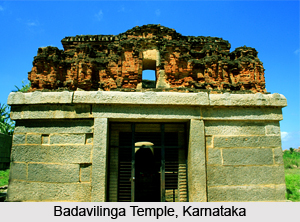 Badavilinga Temple is a Shiva temple located in the region of Hampi in the southern Indian state of Karnataka and boasts of the biggest monolithic Shiva `linga` in Hampi. It is situated close to the statue of `Narasimha` and is thronged by innumerable devotees and tourists every year. The Shiva linga has been established in a chamber which is equipped with a singular opening in front of the temple. There exists a huge circular pedestal or `yoni pitha` attached to the Shiva linga which leads to an outlet which is also referred to as `pranala`. There exists a `three-eye mark` alongside the `Somasutra` or central median line which has been drawn in line carving.
Badavilinga Temple is a Shiva temple located in the region of Hampi in the southern Indian state of Karnataka and boasts of the biggest monolithic Shiva `linga` in Hampi. It is situated close to the statue of `Narasimha` and is thronged by innumerable devotees and tourists every year. The Shiva linga has been established in a chamber which is equipped with a singular opening in front of the temple. There exists a huge circular pedestal or `yoni pitha` attached to the Shiva linga which leads to an outlet which is also referred to as `pranala`. There exists a `three-eye mark` alongside the `Somasutra` or central median line which has been drawn in line carving.
Adequate water has been filled in the sanctum which contains the
 Shiva linga since a water channel is created to flow through it. As per a regional legendary tale, the construction of Badavlinga Temple had been financed by a poverty-stricken peasant woman. This is the reason why the temple is called `Badavilinga Temple` as the term `Badva` implies `poor` in regional dialect. The linga is placed in a huge brick mortar chamber.
Shiva linga since a water channel is created to flow through it. As per a regional legendary tale, the construction of Badavlinga Temple had been financed by a poverty-stricken peasant woman. This is the reason why the temple is called `Badavilinga Temple` as the term `Badva` implies `poor` in regional dialect. The linga is placed in a huge brick mortar chamber.
Hindu mythological account states that Ganga River was invited on earth from the heaven to quench the thirst of mankind and also to relieve them of the severe drought. However the might of the river was enough to split the earth into two different parts if it was permitted to drop onto the earth. Therefore Lord Shiva agreed to let Ganga River fall into His matted hair which would reduce its impact on the earth. Thus the earth was able to receive a beautiful smoothly flowing river, from the hair of Lord Shiva. It is for this reason that one would come across a pot dropping water over Shiva linga in Shiva temples.
This article is a stub. You can enrich by adding more information to it. Send your Write Up to content@indianetzone.com





















